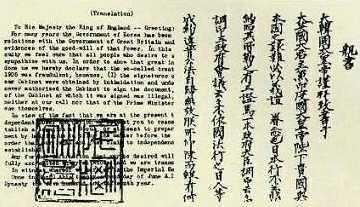Hangul 한일의정서 Revised Romanization Hanil Uijeongseo | Hanja 韓日議定書 McCune–Reischauer Hanil Ŭich'ongsŏ | |
 | ||
The Japan–Korea Treaty of 1904 was made between representatives of the Empire of Japan and the Korean Empire in 1904. Negotiations were concluded on February 23, 1904.
Contents
Treaty provisions
The treaty preamble asserted that the Envoy Extraordinary and Minister Plenipotentiary of His Majesty the Emperor of Japan and the Minister of State for Foreign Affairs ad interim of His Majesty the Emperor of Korea were "respectively duly empowered" to negotiate and to agree upon the specific language of the proposed bilateral treaty:
For the purpose of maintaining a permanent and solid friendship between Japan and Korea and firmly establishing peace in the Far East, the Imperial Government of Korea shall place full confidence in the Imperial Government of Japan, and adopt the advice of the latter in regard to improvements in administration.
The Imperial Government of Japan shall in a spirit of firm friendship ensure the safety and repose of the Imperial House of Korea.
The Imperial Government of Japan definitively guarantee the independence and territorial integrity of the Korean Empire.
In case the welfare of the Imperial House of Korea or the territorial integrity of Korea is endangered by aggression of a third power or internal disturbances, the Imperial Government of Japan shall immediately take such necessary measures as circumstances require, and in such case the Imperial Government of Korea shall give full facilities to promote the action of the Imperial Japanese Government. The Imperial Government of Japan may for the attainment of the above-mentioned object occupy when the circumstances require such places as may be necessary from strategic points of view.
The Governments of the two countries shall not in future without mutual consent conclude with a third power such an arrangement as may be contrary to the principles of the present protocol.
Article VI.
Details in connection with the present protocol shall be arranged as the circumstances may require between the Minister of Foreign Affairs of Korea and the representative of the Empire of Japan.
Recision
This "alleged treaty" was contrived in a coercive process; and Koreans sought to invalidate the unwanted consequences by presenting evidence to the international community. For example,
This treaty was confirmed to be "already null and void" by Treaty on Basic Relations between Japan and the Republic of Korea concluded in 1965. In 2010, Japan argued that the chronological point of reference for "already null and void" was August 15, 1948, when the government of the Republic of Korea was established. This point of view is disputed by the Korean analysis, which construes the 1965 treaty as acknowledgment of the nullification of all Japanese-Korean treaties and agreements from 1904 onwards.
